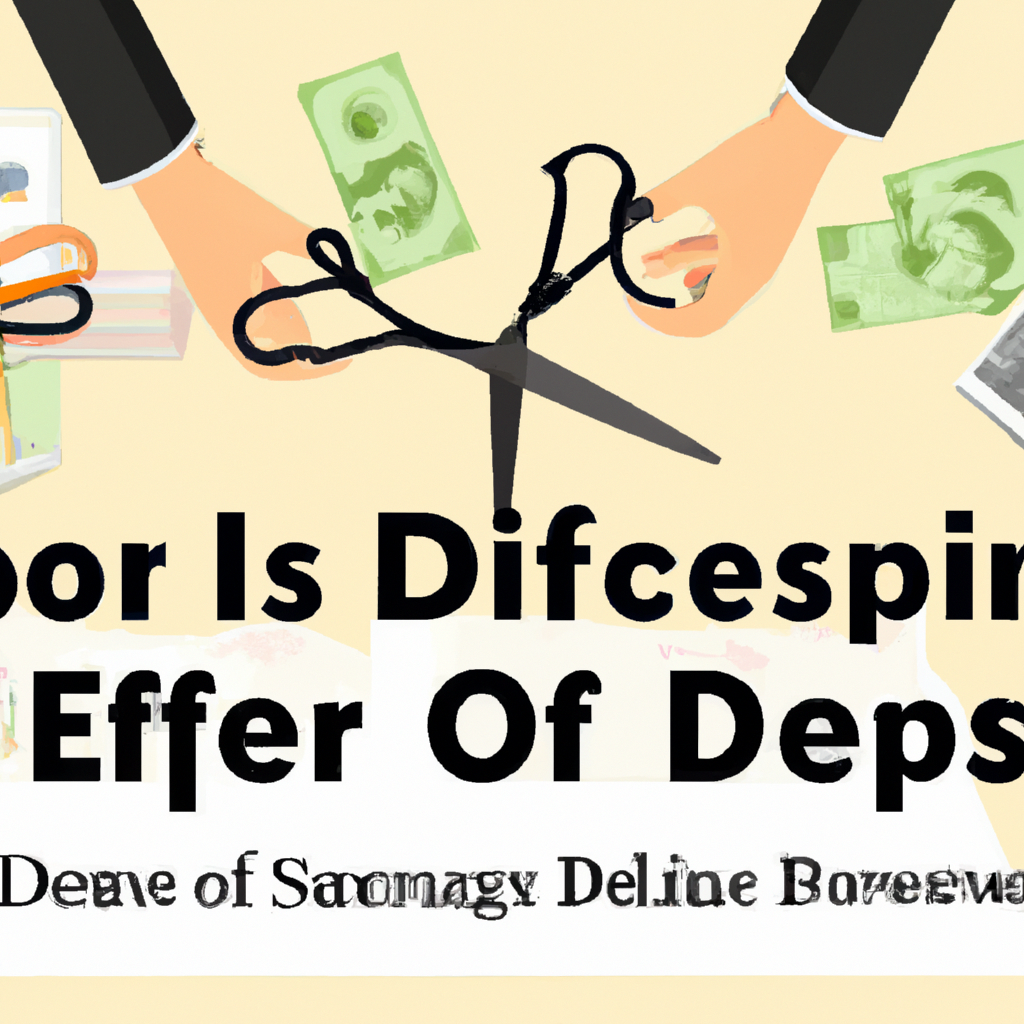Are you feeling overwhelmed by your finances and wondering if cutting out all discretionary spending is the answer? In this article, we will explore the concept of discretionary spending and whether it is necessary to completely eliminate it from your budget. While finding ways to save is important, we will discuss how maintaining a balance between responsible spending and enjoying the little pleasures in life can lead to a healthier financial mindset. So, before you start slashing your budget, let’s delve into the world of discretionary spending and its impact on your financial well-being.
What is discretionary spending?
Definition of discretionary spending
Discretionary spending refers to the money that you choose or have the option to spend on non-essential items or activities. It is the portion of your income that is not allocated for fixed expenses such as housing, utilities, or debt repayments. Unlike necessary expenses, discretionary spending is often related to leisure, entertainment, personal hobbies, and luxury items that enhance your quality of life but are not essential for basic survival.
Examples of discretionary spending
Examples of discretionary spending include dining out at restaurants, going to the movies or concerts, buying new clothing or accessories, taking vacations or weekend getaways, and engaging in recreational activities such as sports or hobbies. These expenses are not essential for your day-to-day existence, but they contribute to your overall happiness, fulfillment, and enjoyment of life.
Assessing your financial situation
Evaluating your income
To understand the impact of discretionary spending on your financial goals, it is crucial to evaluate your income. Calculate the total amount of money you earn each month or receive as a regular income stream. This evaluation will provide a clear picture of how much money you have available to allocate towards both essential and discretionary expenses.
Analyzing your expenses
Analyzing your expenses involves carefully reviewing and categorizing your monthly expenditures. Separate your necessary expenses, such as rent/mortgage payments, utilities, groceries, and transportation costs, from your discretionary expenses. By doing so, you can identify the various areas where you are spending your money and determine the extent of your discretionary spending.
Identifying non-discretionary expenses
Non-discretionary expenses are the essential costs you must pay in order to meet your basic needs and maintain a functional lifestyle. These expenses typically include rent or mortgage payments, utilities, insurance, healthcare, transportation to and from work, and groceries. Identifying your non-discretionary expenses allows you to understand the minimum amount of money required to cover your basic obligations.

Understanding the impact of discretionary spending on your financial goals
Prioritizing financial goals
Financial goals encompass a variety of objectives such as saving for retirement, paying off debt, buying a house, or funding your children’s education. It is important to clearly define and prioritize your financial goals based on their urgency and importance to you. By doing so, you can understand how discretionary spending affects the achievement of these goals.
Considering the importance of discretionary spending
While discretionary spending may not be essential for survival, it plays a crucial role in enhancing your overall well-being and quality of life. Engaging in activities that bring you joy, pursuing hobbies, and indulging in occasional treats can have positive effects on your mental and emotional health. Therefore, it is important to consider the value and satisfaction you derive from discretionary spending when evaluating its impact on your financial goals.
Recognizing potential long-term consequences
Excessive or uncontrolled discretionary spending can hinder your ability to save, invest, and work towards your long-term financial goals. Ignoring the potential long-term consequences of overspending can lead to financial instability, limited opportunities for growth, and increased debt. It is important to strike a balance between enjoying discretionary expenses and maintaining a healthy financial future.
Benefits of cutting out discretionary spending
Increased savings
One of the primary benefits of cutting out unnecessary discretionary spending is the ability to increase your savings. By redirecting the money you would have spent on non-essential items towards savings, you can build a stronger financial cushion, improve your financial security, and have funds available for unexpected expenses or future investments.
Faster debt repayment
Eliminating discretionary spending can help accelerate the process of repaying debt. By allocating money that would have been spent on non-essential items towards debt repayment, you can reduce interest charges and pay off debts faster. This can ultimately save you money in interest payments and bring you closer to achieving debt freedom.
Building an emergency fund
Cutting out discretionary spending allows you to prioritize the creation of an emergency fund. An emergency fund serves as a financial safety net, providing you with a reserve of money to cover unexpected expenses or income disruptions. By saving the money you would have spent on discretionary items, you can establish a robust emergency fund that provides peace of mind and protection against financial uncertainties.
Reduced financial stress
Eliminating or minimizing discretionary spending can significantly reduce financial stress. By avoiding unnecessary expenses, you can avoid accumulating debt or struggling to make ends meet. This leads to a sense of control over your finances, improved overall well-being, and reduced anxiety related to money management.

Challenges of cutting out all discretionary spending
Limited entertainment options
Cutting out all discretionary spending may result in limited entertainment options. Activities such as dining out, going to the movies, or attending concerts may have to be reduced or eliminated. While this can initially feel like a sacrifice, it opens up opportunities to explore alternative forms of entertainment that are more budget-friendly or free.
Social limitations
A challenge of cutting out all discretionary spending is the potential impact on social interactions. Participating in activities with friends or family that involve spending money, such as going out for drinks or attending events, may become less frequent. It can require open communication with loved ones about your financial goals and finding ways to socialize that align with your budget.
Increased temptation to splurge
When you completely eliminate discretionary spending, there is a risk of experiencing an increased temptation to splurge. The restriction on indulging in non-essential items can sometimes lead to a feeling of deprivation, causing impulsive spending or binge-buying. Being mindful of your spending habits and finding healthier ways to address the desire for immediate gratification can help overcome this challenge.
Potential impact on overall happiness
While it is important to be mindful of your financial goals, it is also crucial to consider the impact that cutting out all discretionary spending may have on your overall happiness. Engaging in activities that bring you joy and fulfillment is essential for mental and emotional well-being. It is important to strike a balance between financial responsibility and enjoying discretionary spending in moderation.
Finding a balance
Identifying essential discretionary spending
Not all discretionary spending is created equal. Identifying essential discretionary spending involves distinguishing between items or activities that truly bring you joy and enhance your well-being versus ones that are more frivolous or unnecessary. By focusing on the essential discretionary expenses, you can prioritize areas where spending money brings the most value to your life.
Establishing a discretionary spending limit
To find a balance between enjoying discretionary spending and maintaining financial stability, it is helpful to establish a discretionary spending limit. Set a budgeted amount that you are comfortable spending on non-essential items each month. This allows you to indulge in discretionary expenses while also being mindful of your financial goals and overall budget.
Exploring alternative forms of entertainment
Cutting back on discretionary spending doesn’t mean cutting out all sources of entertainment. Explore alternative forms of entertainment that are more budget-friendly or free, such as picnics in the park, hiking or biking trips, attending local community events, or hosting game nights with friends. These activities can provide enjoyment without breaking the bank.
Seeking free or low-cost activities
Many communities offer a range of free or low-cost activities that can serve as alternatives to more expensive discretionary spending. Look for local museums with free admission days, community classes or workshops, public libraries, or parks and recreation programs. These options can provide enriching experiences without requiring significant financial investment.
Creating a budget
Tracking expenses
Creating a budget is a crucial step in managing your finances effectively. Start by tracking your expenses to gain a clear understanding of where your money is going. Use a spreadsheet, budgeting app, or even pen and paper to record your expenses for a certain period, categorizing them into different types such as housing, utilities, groceries, and discretionary spending. This tracking helps you identify areas where you can cut back and make adjustments.
Setting financial goals
In order to create a budget that aligns with your financial goals, it is important to clearly define those goals. Decide what you want to achieve financially, whether it’s saving for retirement, paying off debt, or buying a home. Specific, measurable, attainable, relevant, and time-bound (SMART) goals provide a roadmap for structuring your budget and making informed spending decisions.
Allocating funds for discretionary spending
When creating a budget, it is essential to allocate funds for discretionary spending. Determine how much money you can comfortably set aside for non-essential items, taking into account your income, necessary expenses, and financial goals. This allocation ensures that you have designated funds available for discretionary spending without jeopardizing your financial stability or long-term objectives.
Determining the appropriate level of discretionary spending in your budget
Considering personal preferences
Determining the appropriate level of discretionary spending in your budget involves considering your personal preferences and values. Reflect on what truly brings you joy and fulfillment, and allocate funds accordingly. By aligning your discretionary spending with your personal values, you can strike a balance between enjoying life’s pleasures and maintaining financial stability.
Evaluating financial limitations
While personal preferences are important, it is essential to evaluate your financial limitations when determining the appropriate level of discretionary spending. Take into account your overall financial situation, including your income, necessary expenses, and debt obligations. Being realistic about your financial limitations helps ensure that your discretionary spending is within a reasonable and sustainable range.
Reviewing spending patterns
A helpful step in determining the appropriate level of discretionary spending is to review your spending patterns. Analyze your past discretionary expenses and evaluate their impact on your overall finances. Identify any areas where you may have overspent or experienced regret. This reflection provides valuable insights and helps guide you towards making more informed choices in the future.
Strategies to reduce discretionary spending
Identifying unnecessary expenses
To reduce discretionary spending, it is important to identify unnecessary expenses. Look for recurring expenses that no longer bring you joy or provide value in your life. Consider canceling unused subscriptions or memberships, cutting back on impulse purchases, or reevaluating expensive habits that may be draining your finances without significant benefit.
Cutting back on non-essential items
Another effective strategy to reduce discretionary spending is to cut back on non-essential items. Prioritize your spending on essential discretionary expenses that bring you the most joy, while limiting or eliminating purchases that you can live without. This requires careful evaluation and consideration of your needs versus wants.
Comparing prices before making a purchase
Before making a discretionary purchase, take the time to compare prices. Research different retailers, both online and offline, to find the best deal and potential discounts. By being a conscious shopper, you can avoid overspending and ensure that you are getting the most value for your money.
Using discounts and coupons
Utilizing discounts and coupons is another effective strategy to reduce discretionary spending. Look for promotional offers, discount codes, or membership benefits that apply to the items or activities you are interested in. By taking advantage of these opportunities, you can still enjoy discretionary spending while saving money in the process.
Revisiting your discretionary spending periodically
Adapting your spending habits to changing circumstances
As your circumstances change, it is important to adapt your discretionary spending habits accordingly. Life events such as a new job, the birth of a child, or a change in financial status may require adjustments to your budget and spending priorities. Regularly revisiting your discretionary spending allows you to reassess your financial goals and make necessary changes to maintain a healthy financial balance.
Reevaluating financial goals
Financial goals are not set in stone and may evolve over time. Periodically revisit and reevaluate your financial goals to ensure they still align with your values and aspirations. This reassessment helps you determine whether your discretionary spending is still in line with your revised goals or if further adjustments are needed.
Making adjustments to maintain balance
Maintaining a healthy balance between discretionary spending and other financial priorities requires ongoing effort. As circumstances change and priorities shift, adjust your budget and discretionary spending limits accordingly. By regularly making small adjustments, you can ensure that your spending aligns with your goals and allows you to enjoy life without compromising your financial stability.
By understanding discretionary spending, assessing your financial situation, and finding a balance between enjoying non-essential items while maintaining financial stability, you can make informed decisions that align with your values and long-term goals. Cutting out unnecessary discretionary spending can lead to increased savings, debt repayment, and reduced financial stress, but it is important to reevaluate and adjust as circumstances change. Remember, finding a balance that works for you is key to achieving both financial success and personal happiness.






